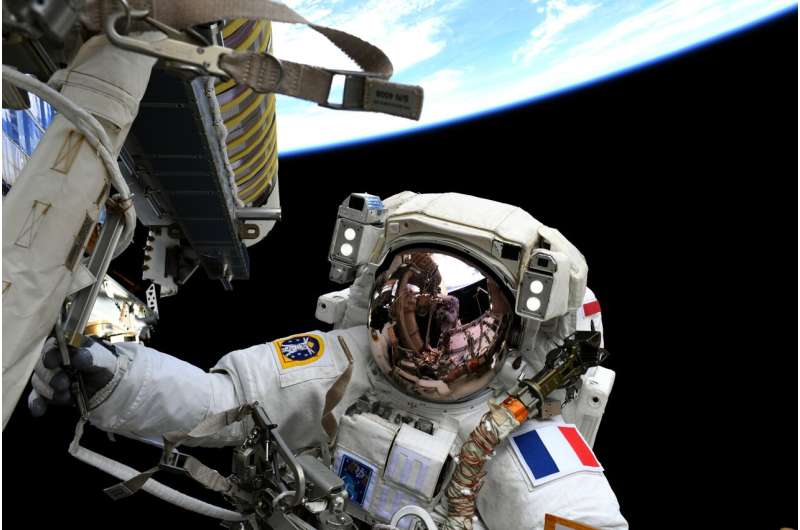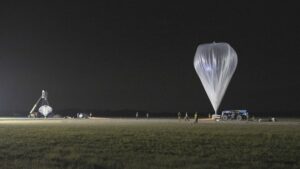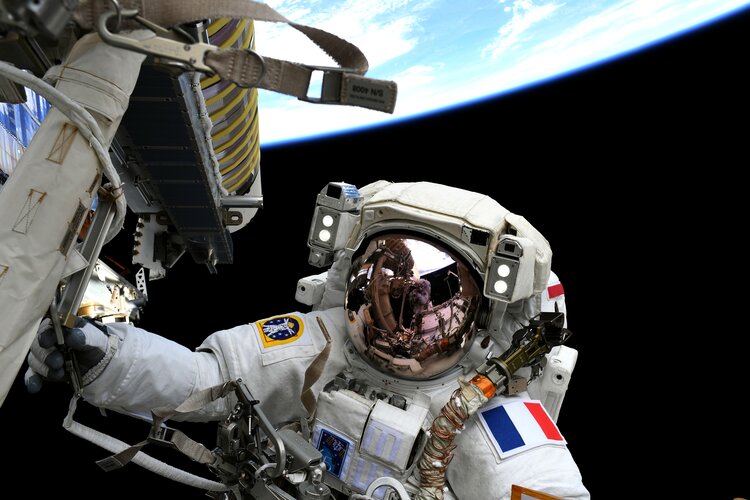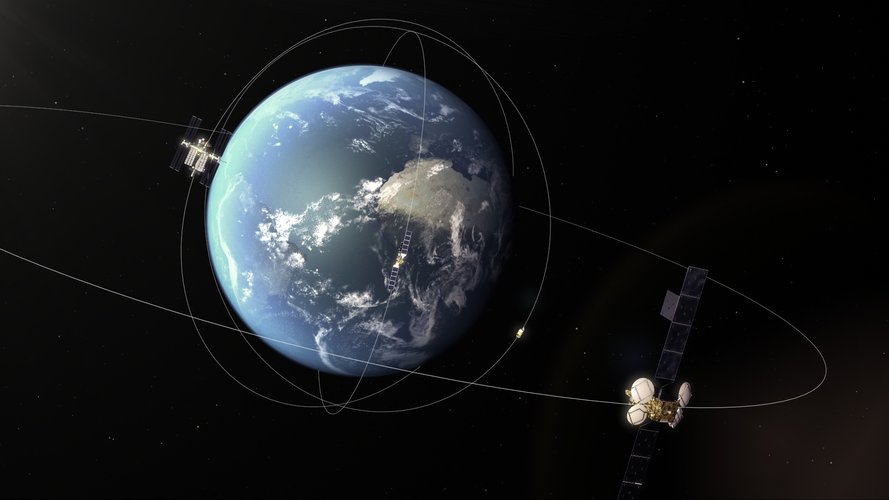Leaf Space expands ground station network ahead of busy SpaceX ride-share mission
Thursday, 24 June 2021 14:29
TAMPA, Fla. — Leaf Space has added three more ground stations to its managed network service, helping the Italian company support its largest number of satellite customers on a single launch in an upcoming mission.
Satellite propulsion supplier Orbion raises $20 million in Series B funding
Thursday, 24 June 2021 14:16
WASHINGTON — Orbion Space Technology, a Michigan-based supplier of electric propulsion for small satellites, announced June 24 it has raised $20 million in Series B funding.
The new funding is to scale up production of plasma thrusters for small satellites, the company said.
Image: Thomas and the blue marble
Thursday, 24 June 2021 14:00
A snap of ESA astronaut Thomas Pesquet during the second spacewalk to upgrade the International Space Station's power system, taken by NASA astronaut Shane Kimbrough.
The duo performed the second extra vehicular activity to bolt in place and unfurl an IROSA, or ISS Roll-Out Solar Array, on Sunday 20 June.
The series of spacewalks last week was not without some challenges. During the first spacewalk on 16 June, Shane experienced a small technical problem in his spacesuit that required him to return to the airlock and restart his Display and Control Module. This module provides astronauts with continuous information on pressure, temperature and other vital data during a spacewalk.
Though the restart was successful and Shane was in no danger, it delayed the duo's work, preventing them from completing installation of the first new solar array as planned.
The duo succeeded in taking the IROSA panel out of its storage area outside the Space Station and passed from spacewalker to spacewalker to the worksite. There the rolled arrays were secured. The spacewalk lasted 7 hours and 15 minutes.
During the second spacewalk, the duo unfolded, bolted and connected the wires.
Space Perspective performs first balloon test flight, begins ticket sales
Thursday, 24 June 2021 13:13
WASHINGTON — Space Perspective, the company planning to offer stratospheric balloon flights for tourists, has formally opened ticket sales days after its first test flight.
Space Perspective announced June 23 it is offering flights on its Spaceship Neptune vehicle, a capsule carried aloft to an altitude of 30 kilometers, for $125,000 per person.
Op-ed | Assessing new launch vehicles on the market
Thursday, 24 June 2021 12:08
Launch service providers and integrators exist at the intersection of two highly specialized fields: launch vehicle development and satellite development. These fields overlap, but generally contain different specialties, with both groups speaking fundamentally different languages.
Thomas and the blue marble
Thursday, 24 June 2021 11:04 Image:
Image:
A snap of ESA astronaut Thomas Pesquet during the second spacewalk to upgrade the International Space Station’s power system, taken by NASA astronaut Shane Kimbrough.
The duo performed the second extra vehicular activity to bolt in place and unfurl an IROSA, or ISS Roll-Out Solar Array, on Sunday 20 June.
The series of spacewalks last week was not without some challenges. During the first spacewalk on 16 June, Shane experienced a small technical problem in his spacesuit that required him to return to the airlock and restart his Display and Control Module. This module provides astronauts with continuous information on pressure,
Using visible light to decompose CO2 with high efficiency
Thursday, 24 June 2021 06:58 Carbon dioxide (CO2) emissions from human activities have risen drastically over the last century and a half and are seen as the primary cause of global warming and abnormal weather patterns. So, there has been considerable research focus, in a number of fields, on lowering our CO2 emissions and its atmospheric levels.
One promising strategy is to chemically break down, or 'reduce,' CO2 us
Carbon dioxide (CO2) emissions from human activities have risen drastically over the last century and a half and are seen as the primary cause of global warming and abnormal weather patterns. So, there has been considerable research focus, in a number of fields, on lowering our CO2 emissions and its atmospheric levels.
One promising strategy is to chemically break down, or 'reduce,' CO2 us NASA balloon detects California earthquake, next stop, Venus?
Thursday, 24 June 2021 06:58 The technique is being developed to detect venusquakes. A new study details how, in 2019, it made the first balloon-borne detection of a quake much closer to home.
Between July 4 and July 6, 2019, a sequence of powerful earthquakes rumbled near Ridgecrest, California, triggering more than 10,000 aftershocks over a six-week period. Seeing an opportunity, researchers from NASA's Jet Propulsi
The technique is being developed to detect venusquakes. A new study details how, in 2019, it made the first balloon-borne detection of a quake much closer to home.
Between July 4 and July 6, 2019, a sequence of powerful earthquakes rumbled near Ridgecrest, California, triggering more than 10,000 aftershocks over a six-week period. Seeing an opportunity, researchers from NASA's Jet Propulsi FAA, Department of the Air Force sign commercial space agreement
Thursday, 24 June 2021 06:58 The Federal Aviation Administration (FAA) and the Department of the Air Force signed an agreement June 15 aimed at eliminating red tape while protecting public safety during commercial space activities at ranges operated by the U.S. Space Force.
The agreement recognizes common safety standards for FAA-licensed launch and reentry activities that occur on, originate from, or return to Cape C
The Federal Aviation Administration (FAA) and the Department of the Air Force signed an agreement June 15 aimed at eliminating red tape while protecting public safety during commercial space activities at ranges operated by the U.S. Space Force.
The agreement recognizes common safety standards for FAA-licensed launch and reentry activities that occur on, originate from, or return to Cape C European system speeds data flow with 50 000 links
Thursday, 24 June 2021 06:45
Valuable data is flowing rapidly from Earth observing satellites back to the planet, thanks to the most sophisticated laser communication network ever built.
NASA, Nelson push for annual moon landings for 'a dozen years'
Thursday, 24 June 2021 02:15 NASA needs crewed lunar landings every year for "a dozen years," the agency's administrator, Bill Nelson, said in a House of Representatives committee hearing Wednesday.
Nelson, who became administrator May 3, said Congress hasn't appropriated enough money for the nation's coming lunar aspirations.
"We want to have these sustained landings over a dozen years, and that's gonna cos
NASA needs crewed lunar landings every year for "a dozen years," the agency's administrator, Bill Nelson, said in a House of Representatives committee hearing Wednesday.
Nelson, who became administrator May 3, said Congress hasn't appropriated enough money for the nation's coming lunar aspirations.
"We want to have these sustained landings over a dozen years, and that's gonna cos Life in these star-systems could have spotted Earth
Thursday, 24 June 2021 02:15 Scientists at Cornell University and the American Museum of Natural History have identified 2,034 nearby star-systems - within the small cosmic distance of 326 light-years - that could find Earth merely by watching our pale blue dot cross our sun.
That's 1,715 star-systems that could have spotted Earth since human civilization blossomed about 5,000 years ago, and 319 more star-systems that
Scientists at Cornell University and the American Museum of Natural History have identified 2,034 nearby star-systems - within the small cosmic distance of 326 light-years - that could find Earth merely by watching our pale blue dot cross our sun.
That's 1,715 star-systems that could have spotted Earth since human civilization blossomed about 5,000 years ago, and 319 more star-systems that Benchmark unveils in-space mobility service to unlock OSAM innovations
Thursday, 24 June 2021 02:15 Benchmark Space Systems, a leading provider of in-space mobility products and services, has announced a breakthrough in-space mobility service that virtually eliminates upfront propulsion equipment costs and boosts on-orbit, servicing, assembly and manufacturing (OSAM) mission revenues by allowing satellite operators and service providers to pay as they go for in-space transport.
SCOUT, an
Benchmark Space Systems, a leading provider of in-space mobility products and services, has announced a breakthrough in-space mobility service that virtually eliminates upfront propulsion equipment costs and boosts on-orbit, servicing, assembly and manufacturing (OSAM) mission revenues by allowing satellite operators and service providers to pay as they go for in-space transport.
SCOUT, an How does China's urine recycling system work in space
Thursday, 24 June 2021 02:15 Storing basic life support materials like water, food and oxygen aboard a space station can be challenging - so much so that some are generated aboard rather than delivered to space.
Chinese scientists have devised a system to recycle water from the urine, breath and sweat produced by astronauts in space, which could save up to 100 million yuan (about 15.5 million U.S. dollars) over a peri
Storing basic life support materials like water, food and oxygen aboard a space station can be challenging - so much so that some are generated aboard rather than delivered to space.
Chinese scientists have devised a system to recycle water from the urine, breath and sweat produced by astronauts in space, which could save up to 100 million yuan (about 15.5 million U.S. dollars) over a peri How astronauts can do laundry during space mission
Thursday, 24 June 2021 02:15 The main goal is to solve the issue of astronauts having to get rid of tonnes of clothes every year, which is then placed in the trash and burned in the atmosphere. Tide is now collaborating with NASA to develop a laundry detergent tailor-made for astronauts to clean their dirty clothes while aboard the International Space Station (ISS). This comes as Tide's parent company, Procter and Gamble (P
The main goal is to solve the issue of astronauts having to get rid of tonnes of clothes every year, which is then placed in the trash and burned in the atmosphere. Tide is now collaborating with NASA to develop a laundry detergent tailor-made for astronauts to clean their dirty clothes while aboard the International Space Station (ISS). This comes as Tide's parent company, Procter and Gamble (P 